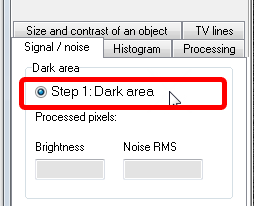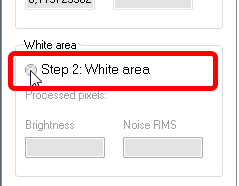With this tab you can measure signal/noise ratio of the image, maximum brightness and brightness difference of the image as well.
Unlike the new similar tab of the Video Analyzer, this tab allows you to measure parameters of a static image in jpg or bmp only, loaded in the Image analyzer.
To measure signal/noise ratio, the image should contain even regions with identical brightness. The square of sections should be not less than 100 pixels. At that, the brightness of these sections should not frequent achieve black and white levels. There should be no roughness in the regions. The roughness will be sensed as noise.
It is recommended to use image without compression or image with minimal compression.
It is better to obtain images using any test chart with a gray scale, for example EIA1956.
Be attentive when measuring the signal/nose ratio of the images, which were influenced by noise reduction. Noise reduction can lead to significant decrease of image resolution. When obtaining test image, it is recommended to switch off all options of digital processing in camera.
While using CCTVCAD Lab Toolkit it is strongly recommended to check Enhance pointer precision checkbox in the Mouse Properties setting in Windows.
Order of measuring
1. Click Load and select image file

When the image will be loaded, the Step 1. Dark area will be switched on.

2. Place the cursor over a dark area of the image, press left mouse button and move the cursor over the dark area holding the mouse button pressed.
|
Read the pixels placed side-by-side in one small size area. Read pixels will be filled in yellow.
|
On the Dark area panel the number of read pixels (Processed pixels) and average brightness (Brightness) of the read pixels are displayed. If reading pixel has zero brightness, sound signal will be produced.
About choice of the dark area in details: The dark area must meet two requirements: 1. Noise at the area should be not be greatly restricted by the black level. 2. It should be exactly the darkest area.
With standard analog cameras it is usually enough to choose the black darkest square on the gray scale. Automation analog camera works in such a way that the black level is kept when changing the light, not cutting off the signal and noise. Complicated analog cameras with digital processing, IP cameras can behave unpredictably. Sometimes while changing light levels some of squares in the gray scale goes for the black level or rise above the black level, black level "floats." In this case we have to choose to measure different areas, making sure that the dark area is really darkest and the noise is not cut by the black level.
|
|
3. After reading of not less than 100 dark pixels, the White area panel becomes available. Click the switch Step 2. White area.

For information on the Dark area panel the calculated root-mean-square noise value (Noise RMS) of dark pixels will be shown.
4. Place the cursor over the white area of the image, press left mouse button and move the cursor over the white area holding the mouse button pressed.
|
Read the pixels placed side-by-side in one small size area. Read pixels will be filled in red.
|
On the White area panel the number of read pixels (Processed pixels) and average brightness (Brightness) of read pixels are displayed. If reading pixel has maximum brightness level, sound signal is produced.
5. After reading of not less than 100 white pixels, the Step 3. Calculation button becomes available. Click on it.

For information on the White area panel the calculated root-mean-square noise value (Noise RMS) of white pixels will be shown.
On the Calculation results panel will be displayed:
| • | Maximum level of brightness; |
| • | Difference between dark and white; |
| • | Signal/noise ratio of the image(dB). |

The Signal/Noise ratio is calculates in the program according to the formula:
SNR=20*Log((W-D)/((Nw+Nd)/2));
where:
| • | SNR - Signal/Noise ratio (dB); |
| • | W- average brightness of pixels in the White area; |
| • | D - average brightness of pixels in the Dark area; |
| • | Nw - root-mean-square noise value of white pixels; |
| • | Nd - root-mean-square noise value of dark pixels. |
The noise is measured twice, in dark and white areas, then the mean value is calculated, to minimize a possible error caused due to the gamma correction.
Unweighted value of signal/noise ratio is calculated as in measurements without weighing filter.
To obtain weighted value add to the result 8 dB.